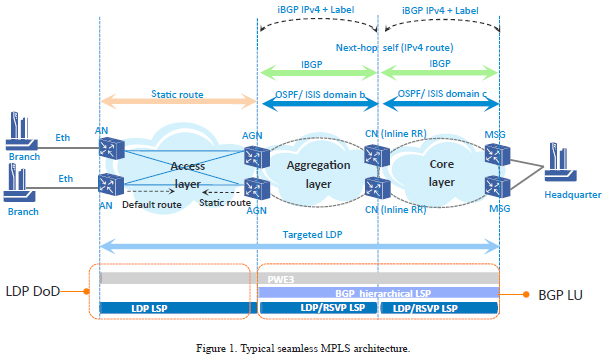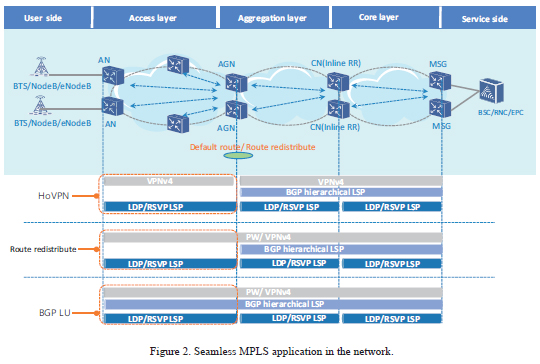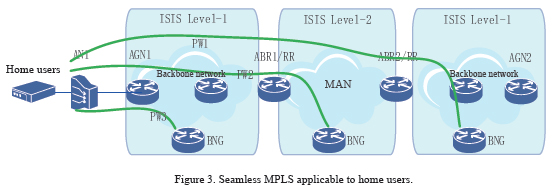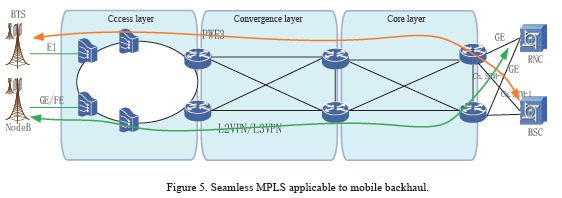Seamless MPLS for Fast and Flexible Service Deployment
Seamless MPLS is a network architecture or network design concept rather than a new protocol or technology. It aims to expand the MPLS domain to the access layer and combine the convergence layer, core layer, and access layer into one MPLS domain. As a result, the entire network based on unified IP/MPLS technologies can carry multiple services.
Seamless MPLS was originally designed to carry metropolitan fixed-line network services. A large amount of layer-3 access devices including convergent OLTs that support simple MPLS label functions are deployed for the upgrade of metropolitan access network. These layer-3 access devices use MPLS PW or L2VPN to carry home broadband services.
The seamless MPLS architecture has the following advantages:
● It uses unified IP/MPLS without extending existing protocols. IP/MPLS is highly mature and facilitates network interoperability among various vendors.
● It provides unified MPLS OAM as well as protection and recovery technologies to implement end-to-end rapid protection switching.
● It enables fast and flexible service deployment. Service configuration is made on access network devices rather than other nodes. This greatly increases service provisioning efficiency. Moreover, service deployment is independent of network architecture. In other words, access points do not need to be aware of MAN and backbone network architecture, and service points can be deployed anywhere in the network.
● It provides unified carriers for fixed-line and mobile networks to carry various services for home users, business users, and mobile base stations. With fixed and mobile convergence, all services are carried in one network.
Seamless MPLS Deployment
Seamless MPLS is deployed through inter-area LDP, LDP downstream on demand (DoD), BGP label unicast (LU), end-to-end rapid protection switching, end-to-end OAM, and entropy label (Fig. 1).

● Inter-area LDP: In a seamless MPLS architecture, MAN and backbone network comprise a complete MPLS domain, and MPLS interaction is implemented between them. RFC 5283 extends LDP and has no constraints on precise routes for inter-area LSP except for the longest route matching. In the seamless MPLS architecture, convergence routes of a backbone network can be notified to each MAN, but detailed routes of each MAN cannot be notified to the backbone network. Thus, the number of IGP routes in each area is reduced, and the network scale is expanded.
● LDP DoD: Because the processing capability and memories of AN devices are not sufficient to handle large amounts of routes and labels, the LDP DoD mode is used to request only necessary labels from the downstream label switching router (LSR). This significantly reduces the number of labels being forwarded.
● BGP LU: Seamless MPLS introduces the BGP LU function. The BGP protocol is used to carry all routes for access network devices. Labels are assigned for these routes, which avoids a large number of routes carried by IGP. RFC 3107 specifies that the BGP protocol is used for assigning labels for unicast routes and is applicable to MPLS L3VPN Option C inter-areas.
● End-to-end rapid protection switching: A seamless MPLS network consists of three parts: LDP DoD interaction between access devices (AN) and convergence devices (AGN), MAN in which IGP and LDP protocols are running and BGP neighbor relationship is established between AGN and ABR, and backbone network in which IGP and LDP protocols are running. The network adopts IGP, LDP, and BGP protocols that can be fast switched to protect network nodes.
● End-to-end OAM: Hierarchical OAM infrastructure is deployed. At the link layer, OAM is used to detect link faults such as IEEE 802.1ag and IEEE 802.3ah. At the tunnel layer, BFD and MPLS OAM (Y.1731) can be deployed for fast tunnel connectivity detection. At the PW layer, BFD or VCCV detection packets are used for real-time check of PW connectivity. End-to-end OAM detection is implemented through OAM detection packets transparently transmitted among users in the network.
● Entropy label: Seamless MPLS packets are forwarded through labels. When there are multiple paths to a destination IP address, load sharing through labels is required. The concept of entropy label is put forward in the RFC 6790 to solve the issue of load unevenly shared by LSR. When a label edge router (LER) performs label negotiation, an entropy label is inserted into a packet. The label value is calculated by the LER according to the source IP address, destination IP address, protocol type, and TCP/UDP port number. Entropy labels are used for traffic load sharing.
Seamless MPLS Application
Seamless MPLS implements connection-oriented services. This greatly increases the efficiency of service deployment and maintenance, helping operators reduce their construction and maintenance costs. Seamless MPLS has been widely applied in mobile backhaul networks and has become the preferred choice for present mobile bearer technology.

ANs only support MPLS LDP functions and a few labels, and do not support the IGP protocol. AGNs, CNs, and MSGs are high-performance MPLS devices. If a default route or a static route of a 32-bit destination IP address is configured on an AN, and a static route whose destination IP address is the AN is configured on an AGN, the route between the AN and AGN is reachable. When the IGP route domain between the convergence layer and the core layer is isolated, AGN and MSG respectively notify their loopback addresses in the form of BGP LU to their peer ends. When receiving the label route and notifications from other neighbors, a CN can set the next-hop of the route to itself. In this way, a one-hop end-to-end BGP LSP can be established between AGN and MSG. ANs use LDP DoD mode to assign labels to service routes. This reduces the number of labels at the access layer and relieves device load. Among AGNs, CNs and MSGs, the LDP DU mode can be implemented or RSVP-TE is used as an outer tunnel. Public routes between AN and MSG are interoperable through static routes and iteration BGP LSPs. In other words, an LDP destination session and end-to-end pseudo wire emulation edge-to-edge (PWE3) can be set up between them.
According to networking and device capabilities at the access layer, there are three solutions for service deployment based on the seamless MPLS concept. When AN devices do not support the BGP LU function, hierarchy of VPN (HoVPN) or route redistribution is deployed at the access layer, and the BGP LU function is enabled only at the convergence layer and core layer. When AN devices support the BGP LU function, the BGP LU function is enabled among the access layer, convergence layer, and core layer to ensure that end-to-end BGP LSPs are set up between ANs and MSGs.
Seamless MPLS can be applied to:
● Home users: Home user services include broadband internet and IPTV services. An AN device can set up multiple PWs as required by services to reach a different BNG in a quick and flexible manner (Fig. 3).

● Business users: Business users require higher security than homer users, and their services can be in or out of MANs. Secure communications are implemented through L2VPNs or L3VPNs (Fig. 4).

● Mobile backhaul: In a mobile network, old base stations use PWE3 to enable packets to be transmitted on the Ethernet. This protects existing investment of operators. For new IP base stations, L2VPNs or L3VPNs can be deployed as required to increase network flexibility for LTE deployment (Fig. 5).
